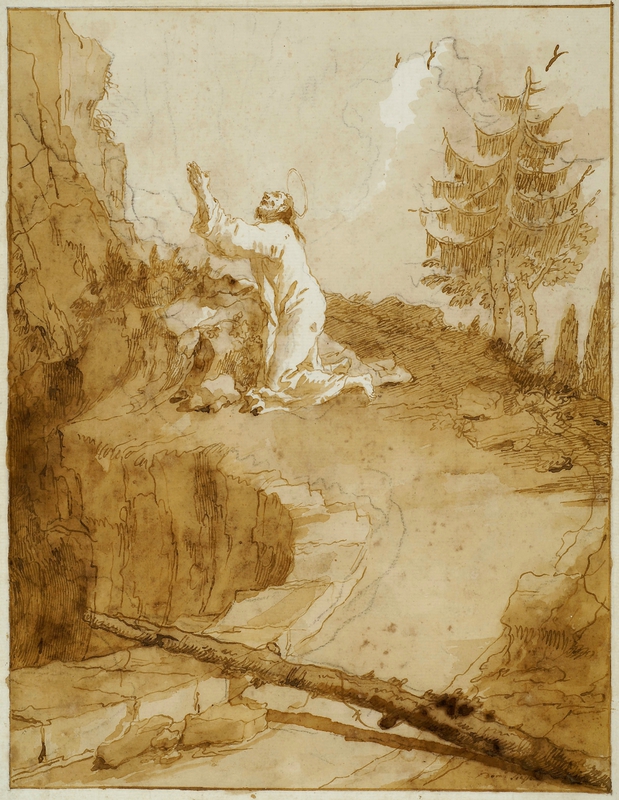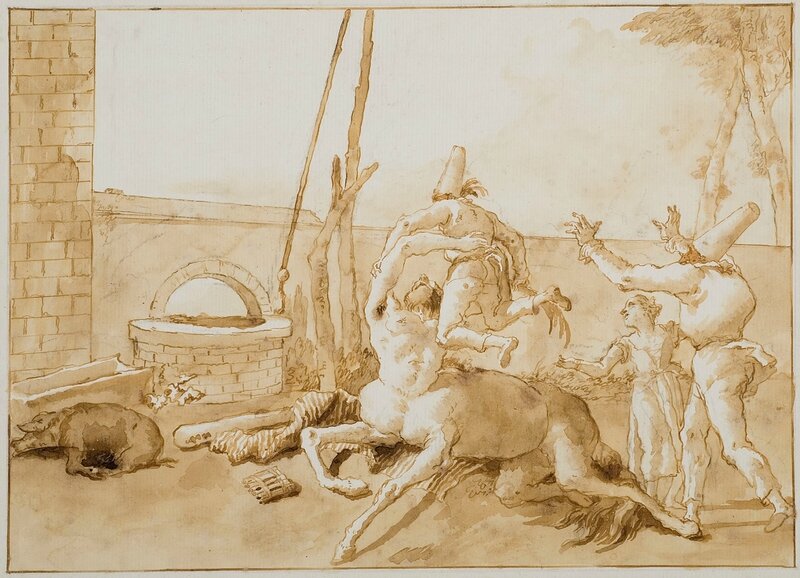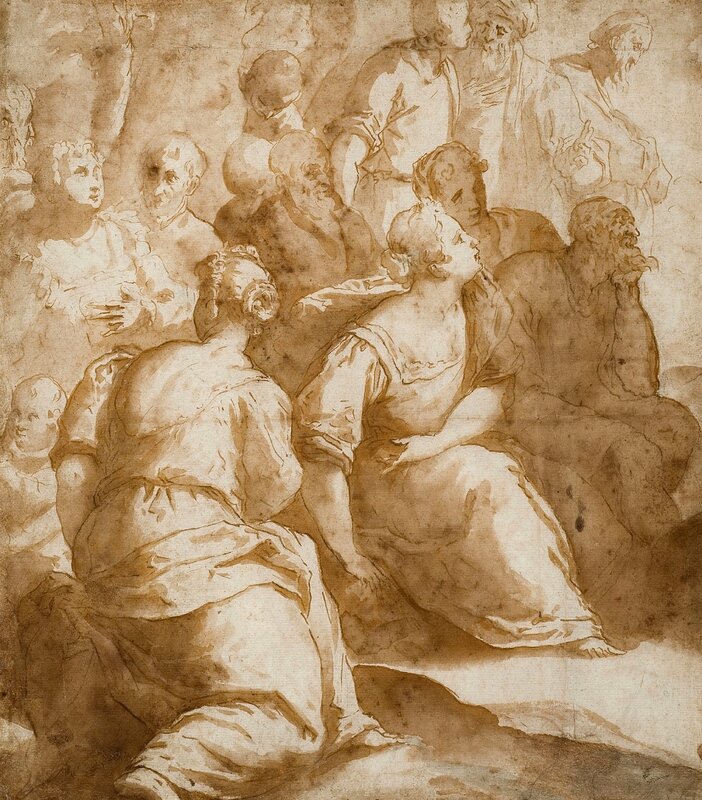Eskenazi Museum of Art at Indiana University mounts exhibition of important drawings by Italian masters
Domenico Tiepolo (Italian, 1727-1804). Jesus in the Garden of Gethsemane: The Second Prayer, ca. 1785. Pen and brown ink wash over black chalk on paper. The Anthony Moravec Collection of Old Master Drawings, Eskenazi Museum of Art, 2010.118.
BLOOMINGTON, IN.- This fall, the Eskenazi Museum of Art at Indiana University showcases a series of Italian master drawings, in an exhibition that highlights one of the most significant gifts of art in the museum’s 75-year history. Giambattista and Domenico Tiepolo: Master Drawings from the Anthony J. Moravec Collection presents a collection of works on paper by the Venetian masters Giambattista and Domenico Tiepolo—a father and son who are widely considered two of the most notable Italian draftsmen of their era—along with works by contemporaries Ubaldo Gandolfi and Giuseppe Bernardino Bison, as well as their predecessor Jacopo Palma il Giovane. Giambattista and Domenico Tiepolo marks the first time that the Eskenazi Museum has comprehensively exhibited the collection of Anthony J. Moravec, an Indiana philanthropist and civic leader who spent five years building the collection in concert with Dr. Adelheid Gealt, the museum’s director emeritus, before donating his holdings to the Eskenazi Museum in 2010.
On view from October 1, 2016 through February 5, 2017, the exhibition and its accompanying catalogue provide new scholarship and curatorial insight on Giambattista and Domenico Tiepolo, two of the most important artists in the Old Masters canon. The exhibition centers on a set of 12 New Testament drawings by Domenico Tiepolo, part of a now-scattered cycle of 320 drawings that is regarded as the most exhaustive and sustained visual exploration of the subject by any artist in history. Domenico’s large pen, brush, and ink drawings were dispersed after his death in 1804, and entered many public and private collections where they were prized as outstanding drawings. However, the actual series to which these individual drawings belonged was not known until two scholars— Adelheid Gealt and George Knox, professor emeritus of the University of British Columbia, Vancouver—spent 10 years piecing the series back together and publishing it as a newly discovered New Testament cycle in 2006.Following Moravec’s 2010 gift, which was the largest private collection of New Testament drawings to enter a public collection in recent history, the Eskenazi Museum hasbecome the world’s third-largest repository of works from Tiepolo’s New Testament series, after the Museé du Louvre and the Morgan Library and Museum.
“Anthony Moravec’s gift of his magnificent collection has dramatically enhanced the Eskenazi Museum’s holdings of 18th-century works on paper, transforming this into a major area of strength for the museum and enhancing our already-significant holdings of European art from the High Renaissance and Late Baroque periods,” said David Brenneman, the Wilma E. Kelley Director of the Eskenazi Museum of Art. “We are deeply grateful to Anthony for his generous gift, which we are proud to showcase through this exhibition.”
Domenico Tiepolo (Italian, 1727-1804). A Centaur Playing with Punchinellos, ca. 1770. Pen and brown ink wash over black chalk on paper. The Anthony Moravec Collection of Old Master Drawings, Eskenazi Museum of Art, 2010.129.
In addition to works from Domenico’s New Testament series, the Moravec collection also includes important works on paper by his father, Giambattista Tiepolo, who is widely regarded as one of the greatest draftsmen of the 18th century. Works by Ubaldo Gandolfi and Giuseppe Bernardino Bison round out the collection, along with a drawing by Jacopo Palma il Giovane—a previously unidentified study for his painting St. John the Baptist Preaching, which was acquired by the museum in 1964. In total, 24 works on paper are being displayed in Giambattista and Domenico Tiepolo, which is a major highlight of the Eskenazi Museum’s 75th-anniversary season.
“This exhibition will reintroduce our audiences to the richness of the Italian Old Master tradition, and especially to the work of Domenico Tiepolo—a unique voice among his contemporaries whose works on paper are notable for their synthesis of Biblical and mythological subject matter with the visual vocabulary of 18th-century Venetian life,” said the exhibition’s curator Adelheid Gealt. “By showcasing our world-renowned holdings of Tiepolo’s New Testament series, the Eskenazi Museum is contributing to an ongoing reassessment of this important body of work.”
Gealt authored an illustrated catalogue to accompany the exhibition, which includes new scholarship on Giambattista and Domenico Tiepolo. The catalogue also features an interview with Anthony Moravec about the origins and history of his collecting practice.
Giambattista Tiepolo (Italian, 1696-1770). The Flight into Egypt, 1735-40. Pen and brown ink wash over traces of black chalk on paper. The Anthony Moravec Collection of Old Master Drawings, Eskenazi Museum of Art, 2010.134.
Palma Giovane [Jacopo il Giovane] (Italian, 1548-1628). Study for St. John the Baptist Preaching, ca. 1620. Pen and brown ink wash on paper. Anthony Moravec Collection of Old Master Drawings, Eskenazi Museum of Art, 2010.128.

/https%3A%2F%2Fprofilepics.canalblog.com%2Fprofilepics%2F1%2F0%2F100183.jpg)
/https%3A%2F%2Fstorage.canalblog.com%2F03%2F02%2F119589%2F96711876_o.jpg)
/https%3A%2F%2Fstorage.canalblog.com%2F11%2F31%2F119589%2F94773502_o.jpg)
/https%3A%2F%2Fstorage.canalblog.com%2F20%2F83%2F119589%2F94772815_o.jpg)
/https%3A%2F%2Fstorage.canalblog.com%2F26%2F72%2F119589%2F75604929_o.jpg)
/https%3A%2F%2Fstorage.canalblog.com%2F59%2F60%2F119589%2F26458628_o.jpg)






/http%3A%2F%2Fstorage.canalblog.com%2F55%2F86%2F119589%2F117921730_o.jpg)
/http%3A%2F%2Fstorage.canalblog.com%2F14%2F28%2F119589%2F31391478_o.jpg)
/http%3A%2F%2Fstorage.canalblog.com%2F04%2F43%2F119589%2F127937064_o.jpg)
/http%3A%2F%2Fstorage.canalblog.com%2F67%2F18%2F119589%2F96371928_o.jpg)